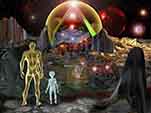Thursday November 09 03:24 PM EST
Severe Solar Storm Threatens Airline, Space Travelers
By Robert Roy Britt
Senior Science Writer, SPACE.com
http://dailynews.yahoo.com/h/space/20001109/sc/severe_solar_storm_threatens_airline_space_travelers_1.html
A severe space weather storm began pounding Earth late Wednesday and is expected to threaten communications, satellite operations and possibly astronauts and airline passengers -- especially pregnant women -- through Sunday.
The event began Wednesday November 8 at 6:50 p.m. Eastern Standard Time (23:50 GMT), when a large solar flare welled up from deep within the Sun. This energy interacted with the solar atmosphere, sending a stream of charged particles called protons heading toward Earth.
"The protons measured near Earth increased 10,000 times in the matter of a few minutes," said Joseph Kunches, lead forecaster at NOAA Space Environment Center.
Forecasters labeled the event an S4. The most severe would be an S5. The event was different from other recent solar storms -- less likely to generate an increase in the northern lights, forecasters said. But at the same time it's potentially more dangerous to humans.
The protons buffeting Earth are a form of radiation that, with extended exposure, is thought to damage DNA and contribute to cancer. While cosmic radiation from distant sources constantly bombards Earth, the amount increases during a severe solar storm.
People on the ground are not at risk, as Earth's magnetic field and atmosphere provide a blanket of protection.
But NOAA says an airline passenger can experience as much radiation as 10 chest X-rays, though this figure is debated. Experts do agree, however, that anyone on a high-altitude jet or in space is exposed to more radiation than someone on the ground.
Wallace Friedberg, who studies the threat for the Federal Aviation Administration (FAA), said that the NOAA estimates are the best available. He said most people planning a flight during the storm should not necessarily change their plans, adding that the radiation measurements he has seen indicate that this event is not the worst possible.
"If it was my daughter, and if she was pregnant, I'd tell her she might want to wait," said Friedberg, who heads the radiobiology research team at the FAA Civil Aeromedical Institute. "If she's not pregnant, I wouldn't be that concerned.
Friedberg has a short flight scheduled himself this weekend. "If I was going today, I would go," he said. "But I'm not pregnant."
High-frequency radio communications will also be strongly affected through Sunday, when the proton stream is expected to die down.
Effect on space travelers
The proton stream is strong enough to be dangerous to astronauts if they are on spacewalks. There are three people --one American and two Russians, living aboard the International Space Station.
"NASA is acutely aware of the fact that there is some hazard to them based on the radiation environment," said NOAA's Kunches. "And today is one of those days that they need to worry."
NASA says the three crew members aboard Space Station Alpha (ISS) are in no danger from the event.
However, flight controllers near Moscow have asked station commander Bill Shepherd and cosmonauts Yuri Gidzenko and Sergei Krikalev to set up a radiation monitoring device inside the Russian-built modules as a precaution.
The portable device, similar to those used during each space shuttle mission, will sound an alarm if it senses radiation that reaches a preset level, said NASA spokesman Rob Navias.
If that should happen, the three crew members will move to the end of the Zvezda service module where the Soyuz spacecraft is docked and remain there until the radiation level subsides. This part of Space Station Alpha offers the most protection from the hazard, Navias said.
In any case there is no need for Shepherd, Gidzenko and Krikalev to move into the Soyuz for protection, nor are there any plans for the crew to evacuate the station and return to Earth.
"This particular solar flare, even if it reaches the levels that would trigger that alarm on board, would have no impact to crew health, or crew safety," Navias said.
But the long-term effects of exposure to cosmic radiation and solar storms are more worrisome, and not entirely known.
NASA keeps an eye on the amount of radiation an astronaut accumulates during several missions, and once they hit their limit they can't fly anymore. What that limit is depends on each crew member, and because of medical privacy it's never been publicly announced that an astronaut won't fly because of radiation concerns.
Airline passenger threat
Scientists have known for nearly a century that the effects of radiation increase with altitude.
There is debate over how much danger an event of this type poses to airline passengers. But experts agree that any potential danger depends on the route of the plane.
"If you fly from Philadelphia to Atlanta, it probably isn't going to have any effect on you," said Kunches, the NOAA forecaster. "Flights in the polar regions are going to be much more susceptible to seeing some effects."
Other scientists say the amount of radiation in the atmosphere can be twice as much at the poles as elsewhere. This is because Earth's magnetic field channels incoming energy toward the poles.
Even on normal flights in non-storm conditions, researchers say the risk to unborn babies might be too great if a pregnant women takes frequent, long flights.
Northern lights
The solar flare also triggered what scientists call a coronal mass ejection. Energy from this type of event takes two to three days to reach Earth, and fuels the colorful displays called the northern lights, or aurora. This storm was not expected to cause significant auroral activity, however.
"The likelihood of a big magnetic storm is pretty low," Kunches said. "It looks like most of the brunt of the material and the energy is going to go off the west limb [of the sun] and away from the Earth."
Visit SPACE.com for more space-related news, information, entertainment and multimedia, including videos, launch coverage and interactive experiences. Check out cool space images at our photo galleries. Follow the latest developments in the search for life in our universe in our new SETI: Search for Life section.
++++++++++++++
FOR THE LATEST ON THE SOLAR STORMS GO TO CYBERSPACE ORBIT
http://www.cyberspaceorbit.com






































